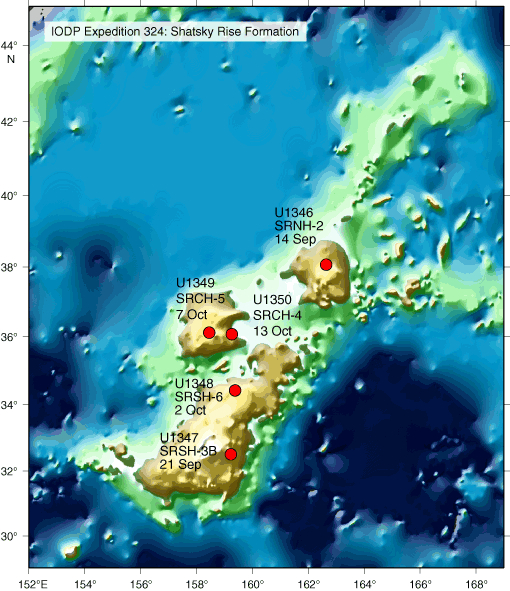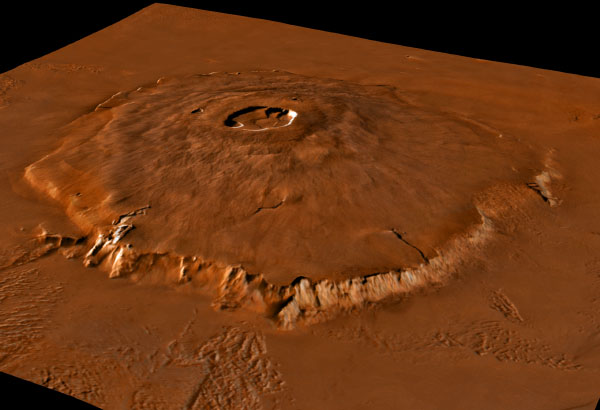

| Visitors Now: | |
| Total Visits: | |
| Total Stories: |

| Story Views | |
| Now: | |
| Last Hour: | |
| Last 24 Hours: | |
| Total: | |
Largest Volcano On Earth Discovered, As Big As New Mexico, Dubbed Tamu Massif, Nearly As Large As Giant Volcanoes On Mars
This 3-D image of the seafloor shows the size and shape of Tamu Massif, a huge feature in the northern Pacific Ocean, recently confirmed to be the largest single volcano on Earth.

Credit: Image courtesy Will Sager
William Sager, a professor in the Department of Earth and Atmospheric Sciences at UH, first began studying the volcano about 20 years ago at Texas A&M’s College of Geosciences. Sager and his team’s findings appear in the Sept. 8 issue of Nature Geoscience, the monthly multi-disciplinary journal reflecting disciplines within the geosciences.
Located about 1,000 miles east of Japan, Tamu Massif is the largest feature of Shatsky Rise, an underwater mountain range formed 130 to 145 million years ago by the eruption of several underwater volcanoes. Until now, it was unclear whether Tamu Massif was a single volcano, or a composite of many eruption points.

Credit: Integrated Ocean Drilling Program

Credit: Image courtesy Integrated Ocean Drilling Program/U.S. Implementing Organization [IODP-USIO]
“Tamu Massif is the biggest single shield volcano ever discovered on Earth,” Sager said. “There may be larger volcanoes, because there are bigger igneous features out there such as the Ontong Java Plateau, but we don’t know if these features are one volcano or complexes of volcanoes.”
Tamu Massif stands out among underwater volcanoes not just for its size, but also its shape. It is low and broad, meaning that the erupted lava flows must have traveled long distances compared to most other volcanoes on Earth. The seafloor is dotted with thousands of underwater volcanoes, or seamounts, most of which are small and steep compared to the low, broad expanse of Tamu Massif.
 Will Sager (left of center, white polo shirt), lead author on the Nature Geoscience study confirming Tamu Massif as the world’s largest volcano, waits to inspect a core sample drilled on IODP Expedition 324 (Shatsky Rise Formation) while IODP technicians prepare to cut it.
Will Sager (left of center, white polo shirt), lead author on the Nature Geoscience study confirming Tamu Massif as the world’s largest volcano, waits to inspect a core sample drilled on IODP Expedition 324 (Shatsky Rise Formation) while IODP technicians prepare to cut it.

Credit: Image courtesy Integrated Ocean Drilling Program/U.S. Implementing Organization [IODP-USIO]

“It’s not high, but very wide, so the flank slopes are very gradual,” Sager said. “In fact, if you were standing on its flank, you would have trouble telling which way is downhill. We know that it is a single immense volcano constructed from massive lava flows that emanated from the center of the volcano to form a broad, shield-like shape. Before now, we didn’t know this because oceanic plateaus are huge features hidden beneath the sea. They have found a good place to hide.”
Tamu Massif covers an area of about 120,000 square miles. By comparison, Hawaii’s Mauna Loa – the largest active volcano on Earth – is approximately 2,000 square miles, or roughly 2 percent the size of Tamu Massif. To find a worthy comparison, one must look skyward to the planet Mars, home to Olympus Mons. That giant volcano, which is visible on a clear night with a good backyard telescope, is only about 25 percent larger by volume than Tamu Massif.
Olympus Mons (Latin for Mount Olympus) is a large shield volcano on the planet Mars.

Credit: NASA
The study relies on two distinct, yet complementary, sources of evidence – core samples collected on Integrated Ocean Drilling Program (IODP) Expedition 324 (Shatsky Rise Formation) in 2009, and seismic reflection data gathered on two separate expeditions of the R/V Marcus G. Langseth in 2010 and 2012. The core samples, drilled from several locations on Tamu Massif, showed that thick lava flows (up to 75 feet thick), characterize this volcano. Seismic data from the R/V Langseth cruises revealed the structure of the volcano, confirming that the lava flows emanated from its summit and flowed hundreds of miles downhill into the adjacent basins.
According to Sager, Tamu Massif is believed to be about 145 million years old, and it became inactive within a few million years after it was formed. Its top lies about 6,500 feet below the ocean surface, while much of its base is believed to be in waters that are almost four miles deep.
“It’s shape is different from any other sub-marine volcano found on Earth, and it’s very possible it can give us some clues about how massive volcanoes can form,” Sager said. “An immense amount of magma came from the center, and this magma had to have come from the Earth’s mantle. So this is important information for geologists trying to understand how the Earth’s interior works.”
Mauna Loa had been called the largest volcano on Earth in volume and area covered.

Credit: USGS
About the University of Houston
The University of Houston is a Carnegie-designated Tier One public research university recognized by The Princeton Review as one of the nation’s best colleges for undergraduate education. UH serves the globally competitive Houston and Gulf Coast Region by providing world-class faculty, experiential learning and strategic industry partnerships. Located in the nation’s fourth-largest city, UH serves more than 40,700 students in the most ethnically and culturally diverse region in the country. For more information about UH, visit the university’s newsroom at http://www.uh.edu/news-events/.
Contacts and sources:
Lisa Merkl
University of Houston





Is that where governments draw “red line” and bomb Mars because of it to be politically correct of an underground volcano that big could be racist.??
They already bombed the moon for being racist and not allowing illegal immigrants to live there
Nice job! It is so nice to discover science is alive and well in some disciplines. http://coldwarwarrior.com/